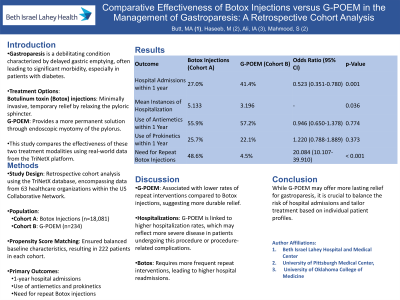Tuesday Poster Session
Category: Functional Bowel Disease
P4070 - Comparative Effectiveness of Botox Injections versus G-POEM in the Management of Gastroparesis: A Retrospective Cohort Analysis
Tuesday, October 29, 2024
10:30 AM - 4:00 PM ET
Location: Exhibit Hall E

Has Audio

Muhammad Ali Butt, MD
Allegheny General Hospital
Pittsburgh, PA
Presenting Author(s)
Muhammad Ali Butt, MD1, Muhammad Haseeb, MD, MSc2, Ijlal Akbar Ali, MD3, Sultan Mahmood, MD4
1Allegheny General Hospital, Pittsburgh, PA; 2University of Pittsburgh Medical Center, Pittsburgh, PA; 3University of Oklahoma College of Medicine, Oklahoma City, OK; 4University of Pittsburgh Medical Center, Wexford, PA
Introduction: Gastroparesis is a debilitating condition often associated with diabetes mellitus, leading to significant patient morbidity. Botulinum toxin (Botox) injections and gastric peroral endoscopic myotomy (G-POEM) are 2 therapeutic options used to manage this condition. Botox injections are minimally invasive and offer temporary relief by relaxing the pyloric sphincter, whereas G-POEM provides a more permanent solution through endoscopic myotomy of the gastric pylorus.
Methods: This retrospective analysis utilized data from the TriNetX platform, encompassing 63 healthcare organizations within the United States Collaborative Network. Out of a total of 1.1 million patients with a diagnosis of gastroparesis, 2 cohorts were identified: Cohort A (Botox Injections, n=18,081) and Cohort B (POEM, n=234). Propensity score matching was employed to balance baseline characteristics, resulting in 222 patients in each cohort. The primary outcomes assessed were 1-year hospital admissions, use of antiemetics and prokinetics, and need for repeat Botox injections.
Results: After propensity score matching, significant differences were observed in the outcomes. Patients in the G-POEM cohort had higher odds of 1-year hospital admissions compared to those receiving Botox injections (odds ratio: 0.523, 95% CI: 0.351-0.780, p=0.001). However, patients in the Botox cohort had a higher mean number of instances of hospital admissions (mean: 5.133 vs. 3.196, p=0.036) and much higher odds of needing repeat Botox injections within one year (OR: 20.084, 95% CI: 10.107-39.910, p< 0.001). There was no significant difference in the use of antiemetics (OR: 0.946, 95% CI: 0.650-1.378, p=0.774) or prokinetics (OR: 1.220, 95% CI: 0.788-1.889, p=0.373) within 1 year between the cohorts.
Discussion: G-POEM appears to be associated with a lower need for repeat interventions compared to Botox injections in the treatment of gastroparesis. However, the higher risk of hospital admissions in the G-POEM cohort warrants further investigation to optimize patient outcomes. The increased hospitalization rates might be due to the potential increased severity of gastroparesis in patients undergoing G-POEM or could be related to the procedure itself. These findings suggest that while G-POEM may offer more durable relief, careful patient selection and management are crucial to minimizing hospitalization risks.
Note: The table for this abstract can be viewed in the ePoster Gallery section of the ACG 2024 ePoster Site or in The American Journal of Gastroenterology's abstract supplement issue, both of which will be available starting October 27, 2024.
Disclosures:
Muhammad Ali Butt, MD1, Muhammad Haseeb, MD, MSc2, Ijlal Akbar Ali, MD3, Sultan Mahmood, MD4. P4070 - Comparative Effectiveness of Botox Injections versus G-POEM in the Management of Gastroparesis: A Retrospective Cohort Analysis, ACG 2024 Annual Scientific Meeting Abstracts. Philadelphia, PA: American College of Gastroenterology.
1Allegheny General Hospital, Pittsburgh, PA; 2University of Pittsburgh Medical Center, Pittsburgh, PA; 3University of Oklahoma College of Medicine, Oklahoma City, OK; 4University of Pittsburgh Medical Center, Wexford, PA
Introduction: Gastroparesis is a debilitating condition often associated with diabetes mellitus, leading to significant patient morbidity. Botulinum toxin (Botox) injections and gastric peroral endoscopic myotomy (G-POEM) are 2 therapeutic options used to manage this condition. Botox injections are minimally invasive and offer temporary relief by relaxing the pyloric sphincter, whereas G-POEM provides a more permanent solution through endoscopic myotomy of the gastric pylorus.
Methods: This retrospective analysis utilized data from the TriNetX platform, encompassing 63 healthcare organizations within the United States Collaborative Network. Out of a total of 1.1 million patients with a diagnosis of gastroparesis, 2 cohorts were identified: Cohort A (Botox Injections, n=18,081) and Cohort B (POEM, n=234). Propensity score matching was employed to balance baseline characteristics, resulting in 222 patients in each cohort. The primary outcomes assessed were 1-year hospital admissions, use of antiemetics and prokinetics, and need for repeat Botox injections.
Results: After propensity score matching, significant differences were observed in the outcomes. Patients in the G-POEM cohort had higher odds of 1-year hospital admissions compared to those receiving Botox injections (odds ratio: 0.523, 95% CI: 0.351-0.780, p=0.001). However, patients in the Botox cohort had a higher mean number of instances of hospital admissions (mean: 5.133 vs. 3.196, p=0.036) and much higher odds of needing repeat Botox injections within one year (OR: 20.084, 95% CI: 10.107-39.910, p< 0.001). There was no significant difference in the use of antiemetics (OR: 0.946, 95% CI: 0.650-1.378, p=0.774) or prokinetics (OR: 1.220, 95% CI: 0.788-1.889, p=0.373) within 1 year between the cohorts.
Discussion: G-POEM appears to be associated with a lower need for repeat interventions compared to Botox injections in the treatment of gastroparesis. However, the higher risk of hospital admissions in the G-POEM cohort warrants further investigation to optimize patient outcomes. The increased hospitalization rates might be due to the potential increased severity of gastroparesis in patients undergoing G-POEM or could be related to the procedure itself. These findings suggest that while G-POEM may offer more durable relief, careful patient selection and management are crucial to minimizing hospitalization risks.
Note: The table for this abstract can be viewed in the ePoster Gallery section of the ACG 2024 ePoster Site or in The American Journal of Gastroenterology's abstract supplement issue, both of which will be available starting October 27, 2024.
Disclosures:
Muhammad Ali Butt indicated no relevant financial relationships.
Muhammad Haseeb indicated no relevant financial relationships.
Ijlal Akbar Ali indicated no relevant financial relationships.
Sultan Mahmood indicated no relevant financial relationships.
Muhammad Ali Butt, MD1, Muhammad Haseeb, MD, MSc2, Ijlal Akbar Ali, MD3, Sultan Mahmood, MD4. P4070 - Comparative Effectiveness of Botox Injections versus G-POEM in the Management of Gastroparesis: A Retrospective Cohort Analysis, ACG 2024 Annual Scientific Meeting Abstracts. Philadelphia, PA: American College of Gastroenterology.

